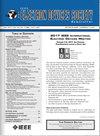p-GaN hemt阈值电压不稳定性与栅漏电流关系的研究
IF 2.4
3区 工程技术
Q3 ENGINEERING, ELECTRICAL & ELECTRONIC
引用次数: 0
摘要
这项工作揭示了栅极泄漏电流($\ mathm {I}_{\ mathm {G}}$)和阈值电压位移($\Delta \ mathm {V}_{\ mathm {TH}}$)之间的温度依赖关系,通过结合深层瞬态光谱(dts)测量、$\ mathm {I}_{\ mathm {G}}$测试和$\ mathm {V}_{\ mathm {TH}}$不稳定性的评估。分析了在80k ~ 440k温度范围内p-GaN栅极缺陷对器件特性的影响。这些结果表明,同一类型的栅极缺陷同时影响栅极泄漏和$\ mathm {V}_{\ mathm {TH}}$失稳。具体来说,缺陷在正栅应力下释放孔洞。在低偏置的$\ mathm {V}_{\text {TH}}$测量过程中,由于缓慢的空穴重捕获,缺陷产生的持续负电荷增强了AlGaN/GaN界面上二维电子气体(2DEG)的耗竭,降低了2DEG密度,导致$\Delta \ mathm {V}_{\ mathm {TH}}$为正。此外,高温栅极偏置(HTGB)应力显著增加了p-GaN栅极内相关缺陷的浓度,导致$\ mathm {I}_{\ mathm {G}}$和$\Delta \ mathm {V}_{\ mathm {TH}}$显著升高。值得注意的是,即使在HTGB应力之后,$\ mathm {I}_{\ mathm {G}} / \Delta \ mathm {V}_{\ mathm {TH}}$比率仍然保持一致。这些观察结果为栅极缺陷与p-GaN栅极HEMT性能之间的关系提供了有价值的见解。本文章由计算机程序翻译,如有差异,请以英文原文为准。
Study on the Relationship Between Threshold Voltage Instability and Gate Leakage Current in p-GaN HEMTs
This work uncovers a temperature-dependent relationship between gate leakage current ( $\mathrm{I}_{\mathrm{G}}$ ) and threshold voltage shift ( $\Delta \mathrm{V}_{\mathrm{TH}}$ ) through an evaluation combining deep level transient spectroscopy (DLTS) measurements, $\mathrm{I}_{\mathrm{G}}$ testing, and assessments of $\mathrm{V}_{\mathrm{TH}}$ instability. Analysis across a temperature range of 80 K to 440 K of p-GaN gate defects on device characteristics. These findings indicate that the same type of gate defects simultaneously affects both gate leakage and $\mathrm{V}_{\mathrm{TH}}$ instability. Specifically, defects release holes during positive gate stress. During low-bias $\mathrm{V}_{\text {TH }}$ measurement, the persistent negative charge from defects, due to slow hole re-trapping, enhances the depletion of the two-dimensional electron gas (2DEG) at the AlGaN/GaN interface, reducing 2DEG density and causing a positive $\Delta \mathrm{V}_{\mathrm{TH}}$ . Furthermore, high-temperature gate bias (HTGB) stress significantly increases the concentration of relevant defects within the p-GaN gate, leading to a marked rise in both $\mathrm{I}_{\mathrm{G}}$ and $\Delta \mathrm{V}_{\mathrm{TH}}$ . Notably, the $\mathrm{I}_{\mathrm{G}} / \Delta \mathrm{V}_{\mathrm{TH}}$ ratio remains consistent even after HTGB stress. These observations provide valuable insights into the relationship between gate defects and the performance of p-GaN gate HEMT.
求助全文
通过发布文献求助,成功后即可免费获取论文全文。
去求助
来源期刊

IEEE Journal of the Electron Devices Society
Biochemistry, Genetics and Molecular Biology-Biotechnology
CiteScore
5.20
自引率
4.30%
发文量
124
审稿时长
9 weeks
期刊介绍:
The IEEE Journal of the Electron Devices Society (J-EDS) is an open-access, fully electronic scientific journal publishing papers ranging from fundamental to applied research that are scientifically rigorous and relevant to electron devices. The J-EDS publishes original and significant contributions relating to the theory, modelling, design, performance, and reliability of electron and ion integrated circuit devices and interconnects, involving insulators, metals, organic materials, micro-plasmas, semiconductors, quantum-effect structures, vacuum devices, and emerging materials with applications in bioelectronics, biomedical electronics, computation, communications, displays, microelectromechanics, imaging, micro-actuators, nanodevices, optoelectronics, photovoltaics, power IC''s, and micro-sensors. Tutorial and review papers on these subjects are, also, published. And, occasionally special issues with a collection of papers on particular areas in more depth and breadth are, also, published. J-EDS publishes all papers that are judged to be technically valid and original.
 求助内容:
求助内容: 应助结果提醒方式:
应助结果提醒方式:


